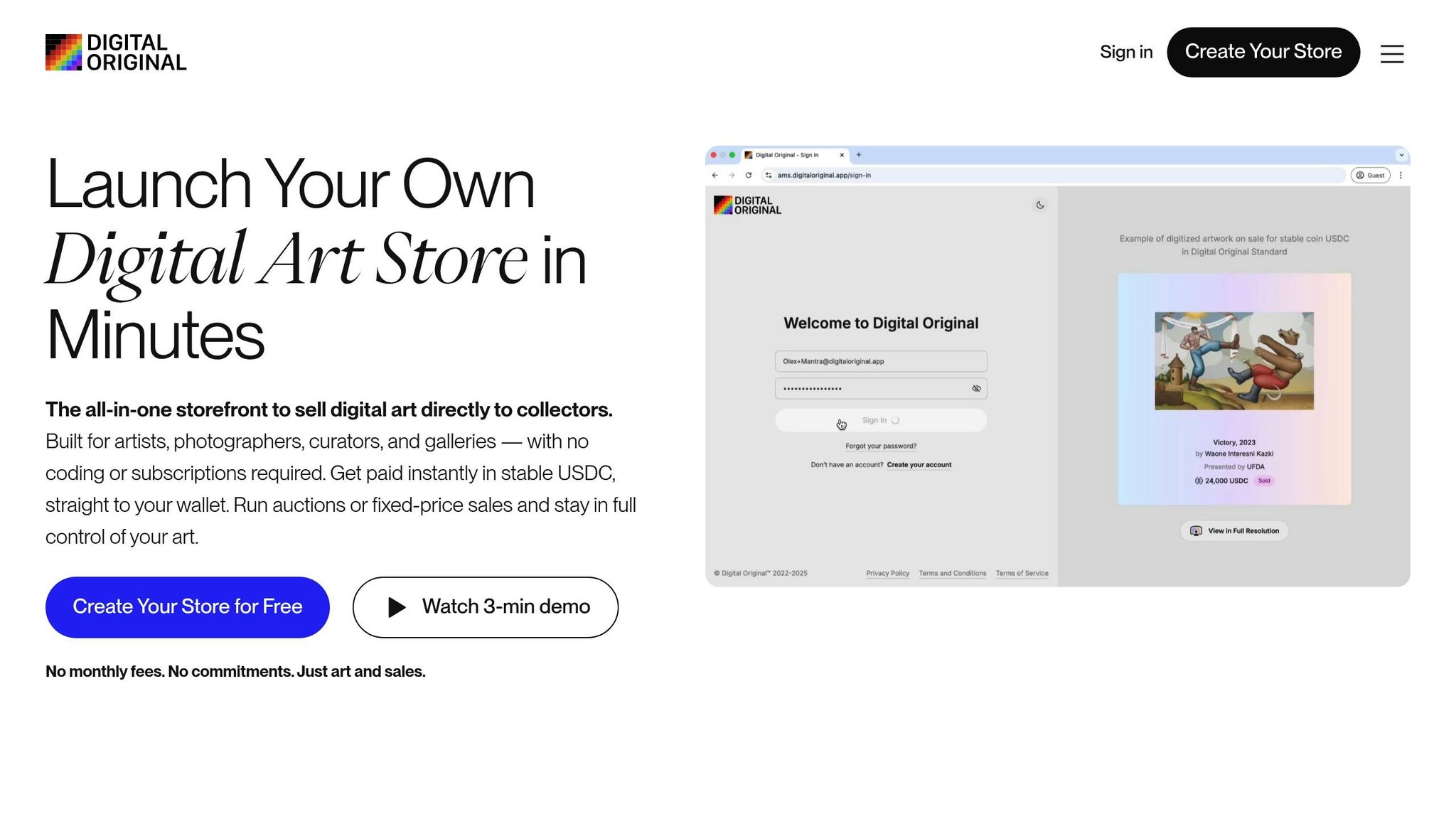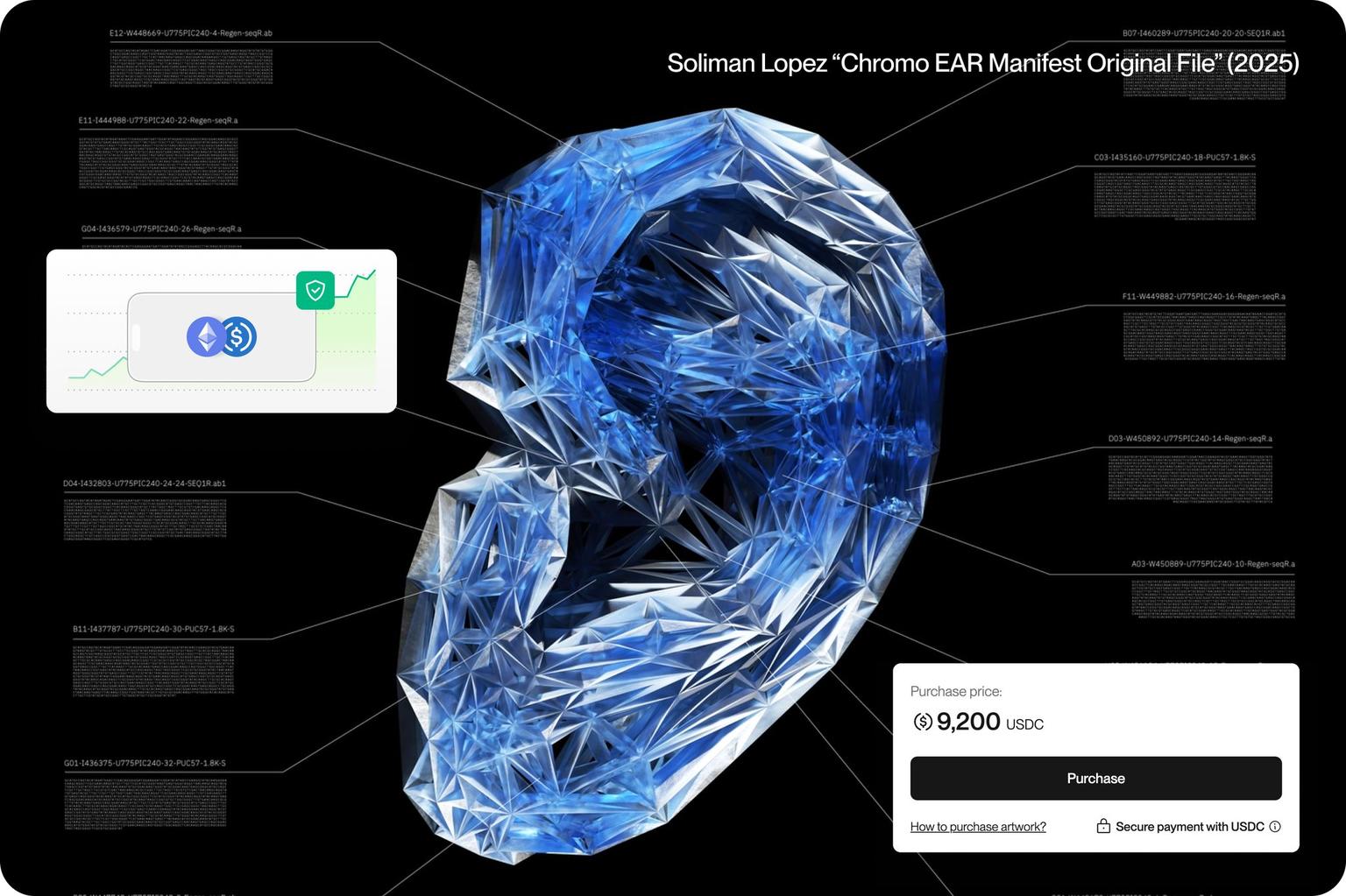Crypto vs. Traditional Payments in Art Sales
Should you accept crypto or stick with familiar payment methods for art sales? Here's the quick answer:
- Crypto payments: Faster, lower fees, and ideal for global transactions, but subject to value changes and limited legal protections.
- Traditional methods: Stable, secure, and widely trusted, but slower and often come with higher fees.
Key points to know:
- Crypto payments process in minutes, even internationally, with fees as low as $5–$50.
- Traditional payments like credit cards and wires can take days, with fees reaching $1,500 for a $50,000 transaction.
- Younger, tech-savvy buyers lean toward crypto, while seasoned collectors prefer established systems.
- Platforms like Digital Original combine crypto's speed with the stability of USD-pegged payments, offering a hybrid solution.
Quick Comparison:
| Aspect | Crypto Payments | Traditional Methods |
|---|---|---|
| Processing Time | Minutes (24/7) | 1–3 business days |
| Fees | $5–$50 | 2.9–3.5% or $15–$80 |
| Legal Protections | Limited | Extensive |
| Stability | Volatile (unless stablecoins) | Stable |
| Buyer Familiarity | Growing | Universal |
Your choice depends on balancing speed, cost, and buyer preferences.
Crypto vs Traditional Payments: Main Differences
Crypto Payments: Fast and Low-Cost
Cryptocurrency payments run seamlessly on blockchain networks that never sleep. Whether it’s Bitcoin, Ethereum, or stablecoins like USDC, these payments can process international transactions in just minutes - something that traditional payment systems often take days to accomplish. For example, a crypto payment lands in the seller’s wallet within minutes, regardless of weekends or holidays. This means an art collector in Tokyo can buy a piece from a gallery in New York at any hour, no delays.
However, network congestion can occasionally slow down Bitcoin transactions. Ethereum, on the other hand, has introduced scaling solutions that help address such delays, making it a more efficient option for faster payments.
Now, let’s see how this speed and efficiency compare to the stability and familiarity offered by traditional payment systems.
Traditional Payments: Reliable and Familiar
Traditional payment methods provide a sense of security and legal safeguards that many buyers and sellers find reassuring. Credit cards, for instance, offer instant approvals, while bank transfers, like ACH, take about 1–3 business days to process.
What sets traditional payments apart is the legal protections they offer. Credit cards come with chargeback options, fraud protection, and well-established dispute resolution mechanisms. These systems are supported by regulatory oversight and customer service teams, making them a trusted choice. Plus, most art buyers are already comfortable using credit cards and bank transfers. This familiarity eliminates the learning curve that comes with explaining digital wallet addresses or how blockchain confirmations work.
Here’s a quick comparison of the key differences between the two payment methods:
| Payment Aspect | Cryptocurrency | Traditional Methods |
|---|---|---|
| Processing Time | Minutes (24/7) | 1–3 business days |
| Cross-border Speed | Minutes | Several days |
| Availability | 24/7/365 | Business hours only |
| Legal Protection | Limited | Extensive |
| Buyer Familiarity | Growing | Universal |
The next section dives deeper into the costs and processing times to understand how each payment method impacts art sales.
Fees and Transaction Speed
When purchasing a $50,000 painting, credit card fees can reach around $1,500, while cryptocurrency network fees typically fall between $5 and $50.
Cryptocurrency Fees and Speed
Cryptocurrency transactions shine when it comes to high-value artwork and international sales. No matter the transaction size, network fees remain consistent - usually between $5 and $50. The speed of these transactions is another major advantage. For example, in December 2024, crypto entrepreneur Justin Sun bought Maurizio Cattelan's conceptual artwork Comedian for $6.2 million at Sotheby's using cryptocurrency. The payment was processed almost instantly, avoiding the delays often associated with traditional wire transfers.
Another benefit of crypto payments is the elimination of additional conversion fees in cross-border transactions. For instance, a collector in Germany buying from a New York gallery can use stablecoins like USDC to bypass foreign exchange fees, international wire fees, and intermediary bank charges.
Crypto payment platforms further simplify international transactions by managing the technical aspects and offering instant currency conversion. Services like Digital Original make this process seamless by providing instant USDC payouts through smart contracts. This means artists and galleries can receive payments immediately, without needing to handle crypto wallets or worry about price fluctuations.
In contrast, traditional payment methods come with slower processing times and higher fees, which can deter buyers and sellers alike.
Traditional Payment Costs and Processing Times
While cryptocurrencies offer low fees and fast processing, traditional payment methods follow a different model. Credit card processors, for example, typically charge 2.9% to 3.5% plus fixed fees. For a $25,000 artwork, this translates to fees ranging from $725 to $875.
Wire transfers, another common method, cost between $15 and $50 for domestic transactions and $35 to $80 for international ones. However, international wires often take 3 to 5 business days to process, during which fluctuating exchange rates can complicate the transaction.
To mitigate these costs, some payment processors allow clients to cover transaction fees.
ACH transfers, while cheaper - typically costing under $1 - require 1 to 3 business days to process. This delay can be problematic, especially when multiple buyers are competing for the same piece of artwork.
The limitations of traditional payments have not gone unnoticed in the art world. Major auction houses like Sotheby’s and Christie’s now accept cryptocurrencies, and institutions such as the Toledo Museum of Art have used crypto to purchase digital artworks. These developments highlight how even established art institutions are embracing faster, more efficient payment methods.
Ultimately, the differences in fees and processing speeds between traditional and cryptocurrency payments are shaping buyer behavior and influencing trends in the art market.
Buyer Preferences and Market Trends
The art market is seeing a clear generational divide when it comes to payment preferences. Younger collectors are embracing cryptocurrency, while more seasoned buyers tend to stick with traditional payment methods. This divide stems from differing levels of comfort with technology, varying attitudes toward risk, and contrasting investment philosophies. These preferences also influence how artists and galleries approach their payment systems, reflecting the distinct priorities of their clientele. Factors like transaction fees, speed, and security play a major role in shaping these choices. Let’s explore how these preferences are shaping the art world.
Crypto Buyers: Tech-Savvy and Forward-Thinking
Millennials and Gen Z collectors are at the forefront of using cryptocurrency for art purchases. Coming from digital-first environments, they see crypto payments as a natural extension of their online lives. The speed and transparency offered by blockchain technology resonate with their expectations, and they’re comfortable managing digital wallets and smart contracts.
For buyers of digital art, such as NFTs, cryptocurrency feels like the logical choice. It streamlines the process, creating a seamless experience from purchase to ownership. Additionally, crypto buyers appreciate the ability to avoid hefty exchange fees, and privacy-conscious individuals value the reduced need for sharing sensitive banking information with intermediaries.
Traditional Buyers: Confidence in Established Methods
More experienced collectors, including institutional buyers, continue to favor traditional payment methods. With years of familiarity using wire transfers, checks, and credit cards, these buyers trust the reliability and legal safeguards that come with these systems.
Older collectors often view cryptocurrency as too volatile for high-stakes art transactions. They prefer the predictability of bank-backed payments and the option to reverse transactions if necessary. Similarly, corporate buyers and museums rely on traditional methods because their financial systems are built around wire transfers and checks. Adopting cryptocurrency would require additional compliance measures, making the shift less appealing.
Traditional payment methods remain the go-to for these buyers, thanks to the stability, legal protections, and established frameworks that ensure smooth handling of high-value art purchases.
sbb-itb-4e84554
Security, Ownership, and Risks
When it comes to securing art transactions and protecting ownership rights, crypto and traditional payment methods take very different paths. Each option has its own strengths and vulnerabilities, which are crucial for artists, galleries, and collectors to evaluate - especially for high-value purchases. These methods not only affect costs and transaction speed but also play a significant role in ownership security and dispute resolution.
As digital transactions become more mainstream, traditional payments lean on established banking systems, while cryptocurrency uses blockchain technology to redefine how we think about security and ownership. Let’s break down how blockchain transparency stacks up against the legal safeguards of traditional payment methods.
Crypto: Blockchain Transparency and Risks
Blockchain technology offers an unchangeable ledger that records every transaction, making it a powerful tool for preventing fraud and double-spending. In the digital art world, NFTs (non-fungible tokens) act as unique digital certificates on the blockchain, proving ownership and authenticity. A notable example is Sotheby's 2024 sale of A.I. God. Portrait of Alan Turing for $1.08 million, where cryptocurrency enabled a transparent payment process and instant transfer of ownership via an NFT.
With smart contracts, ownership transfers and payments happen automatically once conditions are met, reducing human error and disputes. Plus, the transaction history stored on the blockchain creates a reliable provenance trail that paper records simply can’t match.
But crypto isn’t without its risks. Cybercriminals can target crypto wallets and exchanges, posing a real threat to security. Additionally, crypto transactions are irreversible - if a mistake or fraud occurs, there’s little legal recourse to fix it. While cryptocurrencies can provide more privacy by not requiring personal banking details, blockchain’s public nature means that sophisticated analysis can sometimes link wallet addresses to real-world identities.
While crypto payments excel in speed and traceability, traditional methods bring a different kind of reassurance through legal protections.
Traditional Payments: Stability and Legal Protections
Traditional payment options like credit cards and bank transfers come with the backing of regulatory oversight, dispute resolution systems, and insurance, all of which add extra layers of security.
When disputes arise, traditional payments offer well-defined processes for resolution and legal recourse - something crypto transactions generally lack. These methods combine robust bank-level security with consumer protections like fraud reversal and chargebacks, making them a safer bet for many.
Another advantage is price stability. For instance, a $100,000 wire transfer will settle for exactly $100,000, unlike crypto payments, which can fluctuate in value during processing unless stablecoins are used. However, traditional payments have their own limitations. Transactions are processed through private banking networks, which means they lack the transparency of blockchain. This can make it harder to verify an artwork’s provenance or track ownership history. Additionally, paper trails, while standard, are more susceptible to forgery and disputes compared to blockchain’s immutable records.
| Security Feature | Crypto Payments | Traditional Payments |
|---|---|---|
| Transaction Security | Cryptographic security with blockchain transparency, but vulnerable to hacks | Bank-level security with fraud protection and chargebacks |
| Ownership Verification | Instant, verifiable ownership via NFTs | Relies on paper trails, which can be disputed |
| Legal Protections | Limited legal recourse, jurisdiction-dependent | Strong consumer protections and legal support |
| Price Stability | Volatile unless stablecoins are used | Consistent value upon settlement |
| Transaction Transparency | Public blockchain ledger | Private banking networks, limited visibility |
How Digital Original Simplifies Art Payments

Digital Original bridges the gap between the efficiency of cryptocurrency and the reliability of traditional payment systems. It tackles common issues faced by artists and galleries, such as delayed payments and verifying ownership, while simplifying crypto transactions for those unfamiliar with blockchain technology.
Instead of forcing users to choose between the unpredictability of crypto and the sluggishness of traditional methods, Digital Original offers a hybrid solution. It combines the speed of blockchain with the stability of US dollar pricing, removing obstacles that have previously discouraged artists and galleries from embracing digital art sales. Here's how their use of smart contracts and blockchain technology transforms payments and ownership verification.
Smart Contracts and Instant Payouts with Digital Original
Digital Original leverages smart contracts to streamline transactions and eliminate delays. When a collector buys a piece of art, a smart contract automatically transfers USDC (a stablecoin tied to the US dollar) directly to the seller, bypassing manual steps that often slow down payments.
This approach ensures artists and galleries receive their earnings immediately, without worrying about the price fluctuations common in cryptocurrency. For instance, if an artist lists a digital photograph for $500, the buyer’s payment triggers the smart contract to instantly transfer $500 worth of USDC to the artist’s wallet.
The platform also automates royalties for secondary sales. If that same photograph is resold for $800, the smart contract automatically distributes the pre-set royalty amount to the artist.
In addition to fast payments, Digital Original strengthens trust by providing secure blockchain records to verify authenticity.
Verified Ownership and Fraud Prevention
Digital Original uses blockchain to maintain an unchangeable record of each artwork's ownership history. Every transaction is logged, making it impossible to sell counterfeit or stolen art.
This system reassures buyers by allowing them to verify authenticity and provenance instantly. Unlike paper certificates, which can be forged, blockchain records are permanent and tamper-proof.
The platform also enhances transaction security. Encrypted payment processes and smart contracts ensure that transactions are executed only when all conditions are met. This reduces risks like fraud, chargebacks, and unauthorized access, giving both buyers and sellers greater confidence.
Reports show that blockchain platforms significantly lower fraud rates by maintaining transparent, immutable records of ownership and transaction history.
Digital Original supports both digital-native art and digitized physical works. Whether it’s a digital illustration or a scanned painting, the platform uses the same blockchain-based system to verify ownership and process payments securely.
| Payment Feature | Digital Original | Traditional Methods | Standard Crypto |
|---|---|---|---|
| Payment Speed | Instant USDC payouts | 1–5 business days | Instant but volatile |
| Price Stability | Stable (USD-pegged) | Stable | Highly volatile |
| Ownership Records | Blockchain verified | Paper certificates | Blockchain verified |
| Royalties | Automated | Manual tracking | Platform dependent |
| Fraud Protection | Blockchain transparency | Legal protections | Blockchain transparency |
Conclusion: Choosing the Right Payment Method for Art Sales
Deciding between cryptocurrency and traditional payment methods for art sales ultimately comes down to what the buyer values most. Traditional payment options offer reliability and legal protections, while crypto appeals to those who prioritize speed and transparency. These contrasting features highlight key distinctions in fees and transaction details.
In high-value art transactions, traditional payment methods often come with percentage-based fees that can quickly add up. On the other hand, blockchain transactions generally involve lower costs. Buyer preferences also play a role here - many younger collectors are drawn to the digital records and transparency that crypto offers, while more established collectors often lean toward the familiar security of traditional systems. Crypto provides permanent transaction records, whereas traditional methods allow for chargebacks and other legal safeguards.
Given these differences, a hybrid approach stands out as a practical solution. Platforms like Digital Original combine the speed and efficiency of digital payments with the stability of conventional methods. By accepting USD-pegged cryptocurrencies alongside traditional payment options, artists and galleries can offer buyers the flexibility they need.
This dual approach allows sellers to meet the diverse preferences of collectors while addressing the unique demands of each transaction.
FAQs
How does cryptocurrency volatility affect art sales, and what can artists and collectors do to manage the risks?
Cryptocurrency's unpredictable nature can cause significant swings in the value of art transactions, creating hurdles for both artists and collectors. These constant price shifts make it tough to establish consistent pricing for artwork and can lead to financial instability.
To tackle these challenges, many in the art community are opting for stablecoins like USDC, which are designed to maintain a steady value. On top of that, smart contracts offer a secure way to lock in pre-determined payment terms, ensuring both parties are protected. For added security, hedging strategies can help shield against sudden market fluctuations. By leveraging these tools, artists and collectors can embrace the convenience of cryptocurrency payments without being overly vulnerable to its volatility.
What are the security risks of using cryptocurrency for art sales, and how can they be mitigated?
Cryptocurrency has opened up new possibilities for art transactions, offering speed and global reach. However, it also brings certain risks that can't be ignored. Issues like hacking, theft, and fraud highlight vulnerabilities, as blockchain networks, while generally secure, are not completely invulnerable. Beyond that, the absence of clear regulations and the risk of misuse - such as money laundering - pose additional challenges for the art market.
To navigate these risks, artists and collectors can take practical steps to protect themselves:
- Secure your wallets: Use reliable cryptocurrency wallets and safeguard your private keys.
- Enable multi-factor authentication: Add an extra layer of protection to your accounts.
- Stay updated: Keep track of changing regulations and best practices to ensure safe transactions.
With these precautions in place, you can embrace the advantages of cryptocurrency in art sales while keeping your transactions safer.
How does Digital Original improve the art buying experience compared to using only traditional payments or cryptocurrency?
Digital Original reshapes the art buying experience by combining the convenience of cryptocurrency with the familiarity of traditional payment options. It delivers instant USDC payouts, speeding up transactions, and ensures verified digital ownership, providing both security and clarity for buyers and sellers.
By tackling challenges like delays and price fluctuations often tied to cryptocurrency payments, while still offering the ease of traditional methods, Digital Original strikes a perfect balance. This approach appeals to both modern digital collectors and classic art enthusiasts, creating a seamless experience for all.





